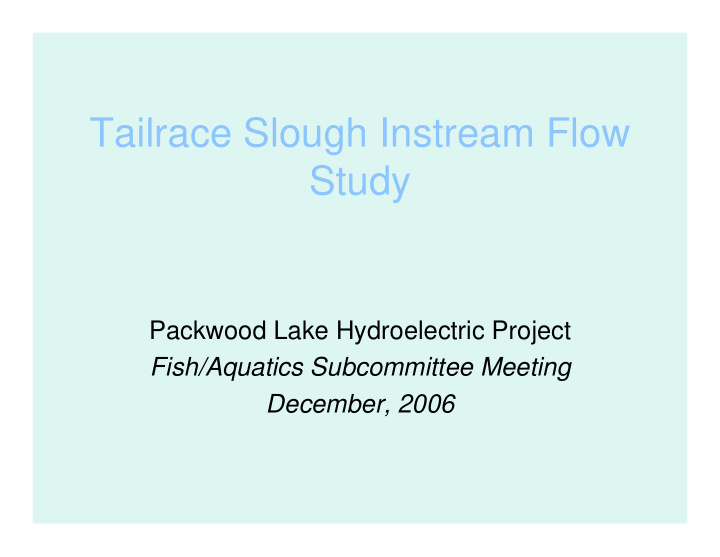



Tailrace Slough Instream Flow Study Packwood Lake Hydroelectric Project Fish/Aquatics Subcommittee Meeting December, 2006
Slough Below Project Tailrace • Tailrace Slough (TS) is used by anadromous salmonids in the spawning life stage: – Chinook Salmon (Observed) – Coho Salmon (Observed) – Steelhead Trout (Potential) – Cutthroat Trout (Potential) • Flows and Habitat in the TS are affected by: – Cowlitz River Flows – Project Operational Flows – Project Operations
Slough Below Project Tailrace (cont’d) • Project Operations Have the Potential to Impact Spawning Habitat in TS – Project has shut down annually for maintenance in October. This can potentially impact redds in the TS.
Cowlitz River and TS are Dynamic • 2004 Tailrace Slough completely dependent upon Project flows, except at very high Cowlitz River flows • 2005 Floods in Dec 2004/Jan 2005 reconfigured TS and TS was mostly dependent upon Cowlitz River flow (20% of Cowlitz R in TS) • 2006 Floods in Jan 2006 again reconfigured TS. – More dependent upon Project Flows, esp. at Low Flows – Cowlitz R contributes 13% ONLY when Cowlitz R Flows > approximately 625 cfs. • Floods in November 2006 again reconfigured TS, with Cowlitz River now contributing more flow.
Tailrace Cowlitz R Cowlitz R Plant Flow Slough Flow Contribution Date Flow (cfs) (cfs) (cfs) (cfs) 2/9/2006 1540 120.1 242.23 122.13 4/12/2006 1260 44.6 112.866 68.266 4/6/2006 1040 44.8 88.85 44.05 2/23/2006 823 75 87.28 12.28 3/9/2006 843 59.6 79.89 20.29 3/28/2006 650 42 44.52 2.52 3/23/2006 604 43 41.04 -1.96
Contribution of Cowlitz R to Tailrace Slough (cfs) 140 r 2 = 0.9746 120 Contibution to Tailrace Slough 100 80 60 40 20 0 0 200 400 600 800 1,000 1,200 1,400 1,600 1,800 -20 Cowlitz R Discharge
Tailrace Instream Flow Study • Project Area: Immediately downstream of Project tailrace downstream to confluence with the Cowlitz River. Includes – Main Channel Below Tailrace (Transportation and Spawning) – Right Channel (Transportation) – Left Channel (Transportation and Spawning)
Tailrace Slough and Cowlitz River (1996) T
Instream Flow Study Issues • How much habitat is available for anadromous salmonids in the TS for: – Chinook Salmon Spawning – Coho Salmon Spawning – Steelhead Trout Spawning • During what time periods are redds most vulnerable to dewatering? • What impact does Project operation have on potential redd dewatering? • What role can the Project have in protecting redds in the TS?
TS Spawning Habitat • Geomorphology Studies currently underway to map and quantify spawning substrates in TS • Transects have been selected to address spawning habitat in: – Main channel, TS – Left side channel, TS • These transects will be used to model habitat and assess dewatering risk
Q meas Trans 8 Trans 7 Q Meas Trans 6 Trans 4 Trans 5 Trans 2 Trans 3 Trans 1
Transects • Transect 1: Glide w/lateral pocket water • Transect 2: Riffle below Split Channel • Transect 3: Split Channel Run (LB larger) • Transect 4: Split Channel Run (RB larger) • Transect 5: Pool • Transect 6: Spawning Riffle/Run on L Side Channel approx. 50 yards DS of confluence w/Main channel • Transect 7: Main channel glide • Transect 8: Plunge pool/run below tailrace
Tailace IFIM Measured Flows 500 450 400 350 300 Discharge (cfs) 250 200 150 100 50 0 Left Channel Right Channel Mainstem
Tailrace Low Flow
Tailrace Middle Flow
Tailrace IFIM – High Flow
November 2006 Flood
November 2006 Flood
Can you see the pool in this picture?
How ‘bout now?
CAVEATS • Channel is dynamic and subject to change – sometimes annually • Results will not provide “the Answer” since the channel is changing all the time • Result will provide a “Snapshot” of how habitat will respond to differences in flow – given the configuration that is measured and modeled at the time.
Recommend
More recommend